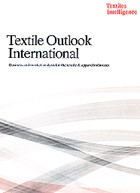Issue
117:
May-June 2005

Product Overview
Buy this Report now
Buy this Issue now
Subscribe
Download brochure (PDF)
Download price list (PDF)
Price list download
| Please choose your preferred currency:
|
Request sample issue
View list of reports
in other issues
|
Multi Report Package |
We also offer a flexible subscription product,
the Multi Report Package,
which allows you to select your own choice of reports from our full range,
to suit your own budget.
Click here for full details.
|
|
 |
Survey of the European Fabric Fairs for Spring/Summer 2006 |

19 pages,
published in Issue 117, May-June 2005
Report price:
Euro 395.00;
US$ 520.00
|
The fashion fabric fairs for the spring/summer 2006 season were overshadowed by uncertainty about the effect of the end of quotas. It was feared that a massive increase of clothing imports into Europe would damage fabric sales to European manufacturers and retail chains. There was concern that some retailers were delaying confirmation of their orders for the previous autumn/winter season until they could get a clearer picture of the situation. The mood in Italy, still the biggest textile producer in Europe, was particularly sombre.
In the event, the fairs were quite busy and an acceptable amount of trade was done. In quality, design and innovation the European industry remains unmatched?for the present. However, producers in countries outside the EU?such as Brazil, India and Turkey?are making rapid progress in upgrading their products. Interestingly, such countries have found that the end of quotas and the predicted surge of Chinese exports have not affected their exports to Europe as severely as they had feared.
The 2006 spring/summer season is set to be another colourful one, but with a subtle difference. The colours are softer and more moderate. Faded, smoky half-tones are much in use. The fabrics themselves continue to become lighter in weight and more complex in construction. In matters such as these, the European industry still sets the tone.
| Six times a year, Textile Outlook International provides up to 200 pages of expert comment and analysis. A subscription provides an overview of the global fibre, textile and apparel industries. It is essential reading for senior executives in the fibre, textile and apparel industries ? and for anyone who is not involved in the industry, but needs to quickly gain an understanding of the key issues. |  | | Reports in Textile Outlook International include: |  | country profiles ? providing a comprehensive guide to the textile and clothing industries in a range of countries and regions. The reports include an economic and political profile together with a comprehensive overview of the main issues, plus an outlook for the future. |  | company profiles ? giving you the opportunity to learn from strategies employed by others. Companies profiled recently include retailers, manufacturers, innovators and sourcing companies involved in textiles and apparel as well as smaller companies which illustrate the opportunities for firms which are interested in selected sourcing locations. |  | trends in world textile and apparel trade and production ? taking into account current issues facing the industry ? such as global fibre prices; competition from China and other low cost countries; the elimination of quotas and imposition of selective new ones; relocation of production operations; the impact of economic factors affecting trade; international trade agreements; trade promotion agreements (TPAs); and much more. |  | trends in EU and US imports of textiles and clothing ? providing comprehensive statistical data and analysis of the top ten supplying countries to the EU and US markets. These reports are updated each year and contain value and volume data as well as average prices and analyses of trends for up to 15 product categories. |  | innovations, technological developments, business development opportunities, individual sector analysis and political implications which affect players in the global fibre, textile and apparel industries. Some of the topics which have been covered in recent reports include: new innovations in the textile and clothing industry, such as environmentally friendly textiles, plant based fibres, and developments in textile colorants; innovations in textile machinery; and overviews of the European swimwear, hosiery and lingerie markets. |  | | So whether you are involved in fibres, textiles or clothing ? in manufacturing, spinning, weaving, knitting, sewing, import/export, retailing ? or if you are in education or consultancy or investment or finance, a subscription to Textile Outlook International will tell you what you need to know about the key trends in the industry. |  | | Textile Outlook International is available on subscription ? either in printed format only, or in printed and electronic format. If you choose the printed only option, you will receive 6 printed publications a year, containing a total of 30 reports plus editorials written by Robin Anson, our editorial director and in-house industry expert. |  | Electronic supplement
If you choose the printed and electronic option, you will receive an extra service. You will still receive each issue in printed format, delivered to you by traditional post. In addition, you will be able to download PDF files containing the same information ? but the PDF files will be available immediately on publication, so you don?t have to wait for the printing and mailing. You also have all the benefits of electronic files: instant access even when you are away from the office; convenient storage in your PC or laptop; portability; electronic search facility; and copy/paste facility. |  |
| This is what our customers say: |
| "Textile Outlook International must be the only one publication that covers the global field from textile till garment production and its sales trend. If anyone reads it carefully, he or she may get some suggestions regarding the future trend or possibility of the said industry." |
| (Toru Oda; JUKI Corporation) |
|
